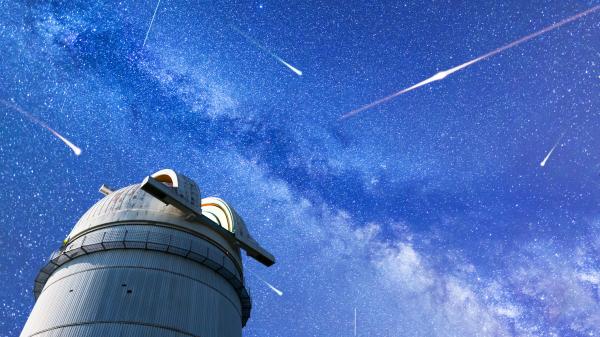What Are Meteor Showers?
A meteor shower is when a number of meteors – or shooting stars – flash across the night sky, seemingly from the same point.

Meteors are also known as shooting stars. They look like a streak of light shooting across the night sky.
©iStockphoto.com/Cylonphoto
Many times a year, hundreds of celestial fireballs light up the night skies. They may be called shooting stars, but they don't really have anything to do with stars. These small space particles are meteoroids and they are literally celestial debris.
Meteor, Meteoroid or Meteorite?
A meteoroid can be dust particles or fragments from a comet or an asteroid.
Whenever a meteoroid enters Earth's atmosphere, it generates a flash of light called a meteor, or shooting star. High temperatures caused by friction between the meteoroid and gasses in the Earth’s atmosphere heats the meteoroid to the point where it starts glowing. The streak of light is the trail of the burning hot air, or sometimes glowing material, which the meteoroid leaves in its wake.
Meteors generally glow for a very short period of time.
If a meteoroid does not fully disintegrate while passing through Earth’s atmosphere and hits Earth, it is known as a meteorite.
What Is a Meteor Shower?
Sometimes, meteors occur in clusters known as a meteor shower.
Since meteoroids that create a meteor shower all move on a parallel path, and at the same velocity, they seem to originate from a single point in the sky to observers on Earth. This point is known as the radiant. By convention, meteor showers, especially the regular ones are named after the constellation that the radiant lies in.
Prominent Meteor Showers
While meteors can occur at any time of the year, some meteor showers occur at the same time every year. Some of the more famous meteor showers have been observed by humans for hundreds and thousands of years.
Quadrantids
Quadrantids is the first meteor shower of every year, usually occurring between the last week of December, and January 12. It peaks around January 3 and January 4 and is best seen from the Northern Hemisphere. The radiant point for the Quadrantids lies in the constellation Boötes, close to the Big Dipper.
Lyrids
The radiant point of the Lyrids lies in the constellation Lyra. This meteor shower occurs between April 16 to April 26th of every year and can be seen from the Northern and Southern Hemispheres.
Eta Aquarids
The next major meteor shower of the year, the Eta Aquarids, occurs between late April and mid-May, peaking around May 5-6. It is best seen from the Southern Hemisphere, though observers in the Northern Hemisphere can also enjoy a sparser display. Meteoroids in the Eta Aquarids are remnants from Halley’s Comet. The radiant for this shower lies in the constellation Aquarius.
Perseids
The Perseid meteor shower occurs in mid-August, reaching peak activity around August 11-13. Its radiant point lies in the constellation Perseus and it is associated with the comet Swift-Tuttle.
Draconids
The Draconid meteor shower, occurs every October, peaking around October 7-8. The name of this shower comes from the constellation Draco the Dragon.
Orionids
The Orionid meteor shower, which is also associated with debris from Halley’s comet, occurs every October, peaking around October 21-22. The name of this shower comes from the constellation Orion.
Leonids
Leonids occur during the month of November, usually peaking around mid-November. It is associated with the comet Tempel-Tuttle and is named after the constellation, Leo.
Geminids and Ursids
The month of December is good for meteor shower watchers, with the Geminids gracing the skies in early December, peaking around December 13-14, and the Ursids that peak around December 22-23. The Geminids owes their name to the constellation Gemini and are the only major meteor shower not associated with a comet, but with an asteroid. Ursids, on the other hand, get their name from the constellation Ursa Minor.
Viewing a Meteor Shower
Meteors are best viewed during the night, though meteoroids can enter the Earth’s atmosphere at any time of the day. They are just harder to see in the daylight. Any ambient light, even from the Moon, is a bane for meteor watchers. Meteors can be best seen away from city lights, on a New Moon night.
Since meteors seem to come from the constellation they are named after, meteor watchers should try and find the direction of the constellation in the sky and look there for meteors.
July and August are some of the best months to observe meteor showers. Along with the Perseid, these months experience several minor meteor showers. December is another good month for meteor watchers.